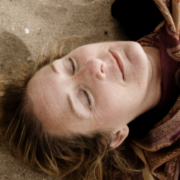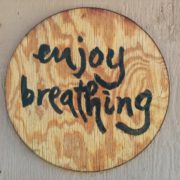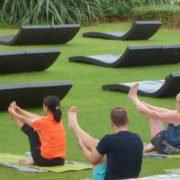Growing up in a family that was “broken” by divorce for multiple generations, I experienced a great deal of stress as a young child navigating the after-effects of such an interpersonal event without any logical awareness that such an event would someday be viewed as trauma. Many people may view post-traumatic stress disorder (PTSD) as a condition that predominately affects our military service members. And while it is true that research focusing on veterans returning from war contributed significantly to the creation of a formal diagnosis of PTSD, the experience of combat is not the only source of trauma leading to this diagnosis.
To support efforts to bring more awareness to the experience of trauma during PTSD Awareness Month, I want to first highlight what type of events and/or experiences may underlie the diagnosis of (complex) PTSD and second, recent research that suggests yoga is a promising complementary treatment that not only helps to reduce the symptoms of PTSD but also supports personal growth, including increasing feelings of compassion, gratitude, acceptance, and empowerment.
According to the National Center for PTSD, types of traumatic events that can lead to PTSD include:
- Combat and other military experiences
- Sexual or physical assault
- Learning about the violent or accidental death or injury of a loved one
- Child sexual or physical abuse
- Serious accidents, like a car wreck
- Natural disasters, like fire, tornado, hurricane, flood or earthquake
- Terrorist attacks
And as I talked about last month, the Adverse Childhood Experience Study (ACES) measured additional types of childhood trauma, leading to a diagnosis of complex PTSD, including the following:
- Personal trauma
- Physical abuse
- Verbal abuse
- Sexual abuse
- Physical neglect
- Emotional neglect
- Trauma related to other family members
- A parent who is an alcoholic
- A mother who is a victim of domestic violence
- A family member in jail
- A family member diagnosed with a mental health disorder
- The disappearance of a parent through divorce, death or abandonment
As the understanding of how the human body-mind interprets situations that don’t appear immediately life-threatening from the casual observer but none-the-less traumatizing to the person grows, it is vital that alternative treatments beyond medication and therapy be considered when considering the percentage of the overall population impacted by such experiences. When considering complex PTSD which stems from a child’s inability to utilize the body’s natural “flight or fight” distress response to escape from a destructive family dynamic, such as the psychological ware zone of a contentious divorce, the body is forced into a freeze response for survival.
In this freeze state, the body is still full of adrenaline and cortisol, yet the child shuts down, dissociating from the body’s natural response sensing its inability to help. At this point of development, the logical brain’s cognitive abilities to understand and act are still forming, so the body and mind are at odds, where the body continually senses danger yet the mind feels helpless to relieve the threat. Symptoms that reflect a diagnosis of complex PTSD include:
- Loss of emotional and physical awareness
- Dissociative episodes
- Self-harming behaviors
- Difficulty regulating emotions, such as anger
- Somatic complaints, such as headaches and stomach aches
- Overdeveloped sense of responsibility
- Chronic sense of guilt
- Difficulty trusting people or feeling intimate
- Helplessness
- Hopelessness
As a “thriver” post PTSD and a trauma-informed yoga practitioner, teacher, and psychotherapist, I understand the need to engage both the body and mind along the healing journey toward re-integration and balance after trauma. So it is not only important to familiarize ourselves with the nature and impact of trauma but it is vital to know what treatments are available and found to be effective so we can guide our loved ones with compassion towards healing and provide hope.
My own journey of healing first led me to the traditional psychotherapy experience, which did help to move me from victim to survivor through awareness and understanding. However, I still found myself chronically anxious and easily triggered into an unbalanced state of mind. Then I found myself in a yoga class. I was immediately hooked by the change I experienced in my body that day, although not completely aware of what the change was exactly. After integrating a regular physical yoga pose and breath practice on the mat into my life, I increasingly became aware of a palpable sense of relaxation in my body and a sense of peace in my heart. My breath pattern became a reflection of my state of mind and a guide toward maintaining balance in my body-mind connection. I learned that I could control my breath and when I focused on my breath I was able to change my reaction to a trigger to a response to a stimulus. I found that the breath creates space to keep the body-mind aligned when navigating the world. As I continued my practice and explored additional mindfulness techniques over time, my capacity for gratitude and compassion grew, I felt more connected to myself and others, I was more accepting and less judgmental, and my ability to remain centered even in chaos has steadily increased.
With my own personal healing journey as evidence that body-mind strategies are necessary to turn off the sympathetic nervous system and release chronic tension in the body, and reflect to discover the beauty in our challenges, I am excited to share some recent research that supports my experience with yoga as an important treatment option for complex PTSD. In this study, 31 adult women with PTSD related to chronic childhood trauma participated in a 10-week Trauma Sensitive Yoga (TSY) class. For the results, click on the link below:







